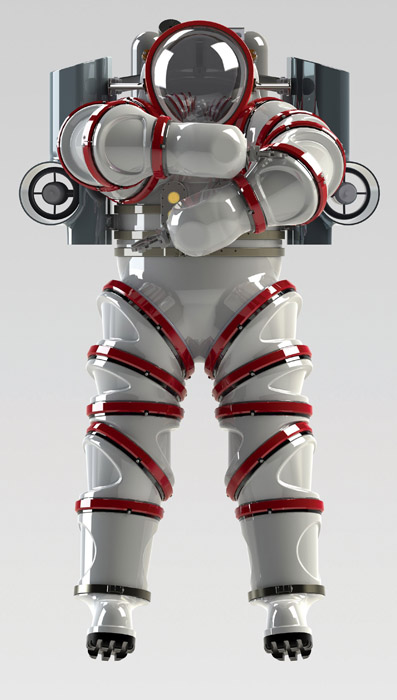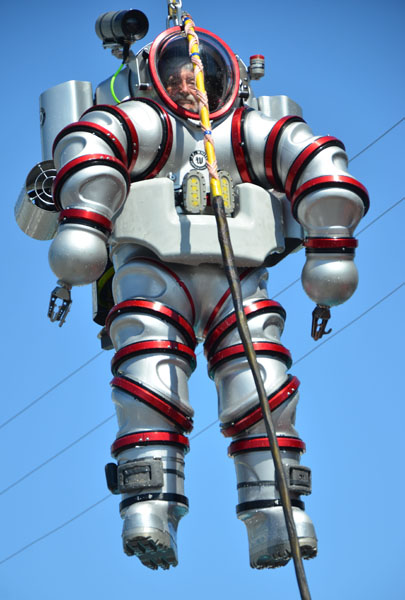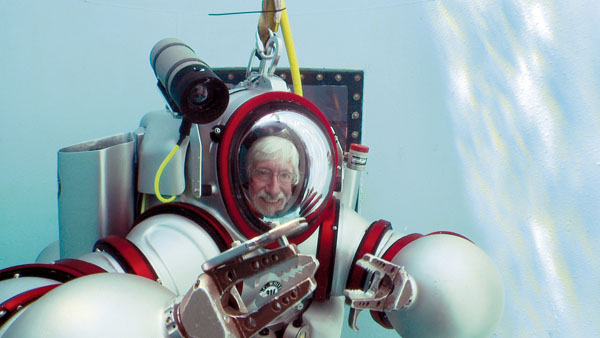EXOSUIT: The Case For One – Atmosphere Diving
First Published in DIVER Volume 38 Issue 5
By Phil Nuytten

The problem: A swillion, or so, years ago, we humans were designed (or evolved, or left here by aliens – please substitute your desired flavour) to function best under a fairly rigid set of specifications. These specs include sea level pressure, specific body temperature, sufficient light to avoid walking into doors, and a fuel gas pressure of 2.94 psi. These ‘specifications’ could just as accurately be called ‘limitations’.
On this planet of ours the greatest difference in relief is a mere 15 miles, give or take. The highest mountain is about seven miles up and the bottom of the Marianas Trench is, coincidently, just over seven miles down. We can’t go to the top of Mount Everest the way we were born: naked, freezing, needing 20 percent oxygen and not finding it. We sure as hell can’t go to the ultimate bottom of the ocean the way we were born! So, here we are stuck, in a narrow band around sea level; stuck here by our physical inabilities, slaves to gravity and a long list of other limitations. Sure, we can extend our natural range a bit, but only a very little bit – a breath-hold dive, for example. But stray too far and the results are catastrophic…. PHUT!! Gone to boot hill.
“But,” you may say, “Hang on, we do go way, way outside our guidelines every day! We get on aircraft and fly to Europe, or get on a cruise ships and cross oceans, get in a submersible and go to the bottom of the sea or get on a spacecraft and travel to the moon!” Yes, absolutely right, thank you for making that point.
The solution: How do we accomplish these seemingly impossible stunts? TECHNOLOGY, or more specifically, the ‘Armour of Technology’. This is just a fancy way of saying ‘devices’, ‘contraptions’, ‘machines’ – clever stuff that we conjure up and then fabricate to allow us to get around those nature-imposed rules that hold us back. Can’t fly? Get inside something that can. Adjust the cabin pressure to a comfortable level, turn on the heaters and blowers to get the temperature to where you want it – and make sure that you have plenty of air with the right percentages of oxygen and nitrogen.
 Finding a Solution
Finding a Solution
Sound familiar? Sure, SCUBA GEAR! Air? On your back. Temperature? Wet or dry suits. Vision? An air-holding mask with a transparent port. Locomotion? Polymer ‘flippers’. Gadgets, contraptions, devices. Okay…so what’s the downside, what’s the problem with good ol’ SCUBA gear? In a word: PRESSURE, or, (in two words) differential pressure. The physiological hazards of diving while exposed to outside pressure (ambient pressure diving) are many. Some you know very well, others may be just a faint memory from your long-ago dive course. They include: decompression sickness (DCS), high pressure nervous syndrome (HPNS), hypercapnia, hypoxia, nitrogen narcosis and various barotrauma events involving the natural air spaces of the body – sinuses, teeth, ears, etc. Most of these problems are significantly exacerbated with increased depth. Deep gas-divers, for example, face the additional hazard of residual damage from repetitive or prolonged exposure – bone necrosis being one of the lead pressure-induced problems.
So, the obvious answer to the problem is not to be exposed to ambient pressure at all, but to remain at surface pressure. There’s no question that quitting diving is one drastic solution. If that’s not acceptable, then what is needed is a contraption, a device, a technological suit of armour – a submarine that you can wear – an atmospheric diving suit (ADS).
A new idea? Nope. The history of ADS is generally accepted to have started with an Englishman named John Lethbridge. Lethbridge invented and used a device he called the “Diving Engine without Communication of Air”…in the year 1715. Essentially, it was an oaken barrel with a sight glass. His arms stuck out through holes in the sides of the sealed barrel and the sleeves were made watertight by leather cuffs. With this device, Lethbridge reported, “I have been ten fathoms deep many a hundred times.” He also reported bottom time at about half an hour. (A colleague of mine, Robert Stenuit, built a replica of the Lethbridge device and reports that it actually worked!)
From that point on, there have been many attempts to build a fully functional ADS that would allow the wearer to go to ‘great depths’ and stay there for hours without ever being exposed to the physiological hazards of pressure. Skipping over the scores of patents for ADS that either didn’t work because the inventor didn’t really understand the magnitude of the problem (the need to design a limb joint that would function properly under huge total pressure loads) and those that might have worked if the materials technology had been further advanced at that time, the first modern ADS is generally accepted to be the ‘Jim’ suit, built in the UK in 1969. ‘Jim’ utilized a joint design that was patented by Joseph Peress and used on a prototype ADS called the ‘Tritonia’ to dive on the wreck of the ‘Lusitania’ in the 1930’s. (I knew Peress in his last years and can attest to the fact that the man was an engineering genius in every sense of the word. PN)

How Affordable?
Probably the best known of the recent ADS series was the ‘Newtsuit’, a thousand foot rated ADS patented by yours truly in 1985 and sold to navies all ’round the world for submarine intervention.
All of these ADS devices have shown a slow but steady progression in depth rating, ease of limb movement, thrusters, life support, ancillary equipment, etc. The corollary is very much like
the initial flight of the Wright brothers ‘Kittihawk’ leading up to the modern aircraft of today and even to the recently successful ‘space planes’.
So, to cut to the chase after a very long (and possibly boring) lead up: What we need is a ONE ATMOSPHERE SCUBA SUIT! A free-swimming suit that will protect the wearer from all the effects of high ambient pressure and totally eliminate all the nasty physiological hazards previously mentioned. How likely is that? If I have my way, pretty darn likely.
Hard on the heels of our most recent ‘Exosuit’ ADS comes a lightweight, swimming ADS design. The initial model probably will be rated for continental shelf depths, say 600 feet, or so. Life support should run not less than 20 hours and locomotion would be use of flippers in ‘almost’ the conventional manner. The most difficult task that our Nuytco team can foresee is neither technical nor mechanical: it is getting the selling price down to a palatable level, initially something around the price of a luxury sports car. We think that we sell enough at that level to allow us to further reduce the price down to a point that any serious diver can afford. Possible? Well, on the commercial ADS side, we were able to cut the price of the ‘Exosuit’ down to around half the price of previous ADS models.

Picture this:
Jump into your ‘Exo-swimmer’ (hopefully, we’ll be able to come up with a jazzier name) and drop down to few hundred feet. You’ll be in continuous wireless contact with the surface, you’re warm and dry and you have all day to explore, to work, to capture fabulous images or just to look around you and marvel that you are there at all. Man! It sure sounds good to me – so, stay tuned!








